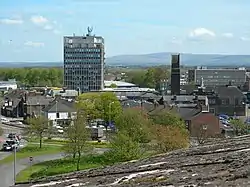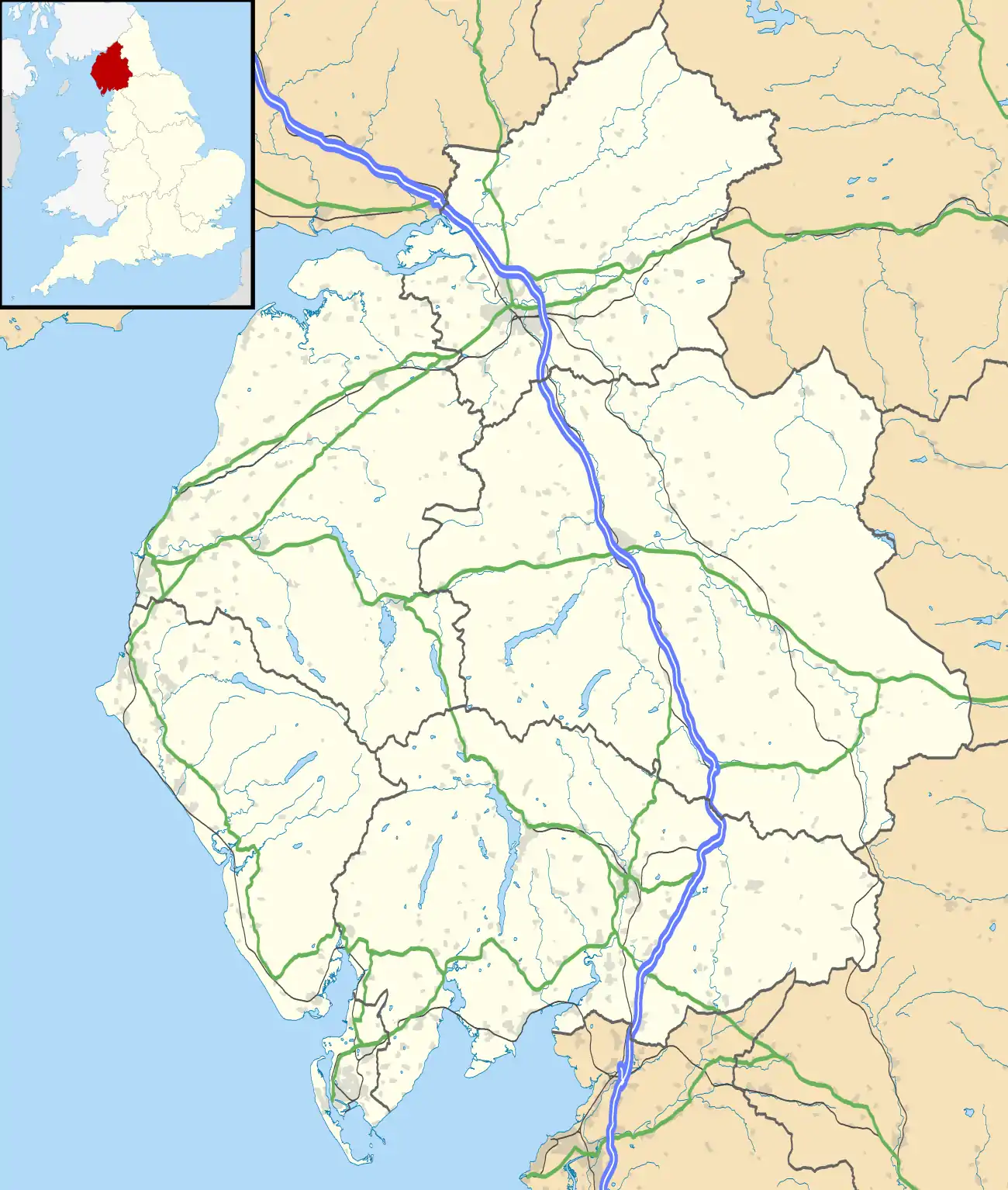Carlisle Civic Centre
Carlisle Civic Centre is a municipal building in the Rickergate, Carlisle, England.
| Carlisle Civic Centre | |
|---|---|
 Carlisle Civic Centre | |
| Location | Rickergate, Carlisle |
| Coordinates | 54.8975°N 2.9347°W |
| Built | 1964 |
| Built by | John Laing & Son |
| Architect | Charles B. Pearson and Partners |
| Architectural style(s) | Modernist style |
 Shown in Cumbria | |
History
.jpg.webp)
The civic centre was commissioned to replacing the aging Town Hall in the Market Place.[1] The new building, which was designed by Charles B. Pearson and Partners in the Modernist style and built by John Laing & Son at a cost of £820,000, was completed in March 1964.[2] The design involved a tower, 44 metres (144 ft) high,[3] as well as a separate two-storey octagonal building to accommodate the council chamber.[4] In 1965, a huge back-lit mural depicting local scenes, which had been painted by Trewin Copplestone, was hung in the council chamber.[5] The octagonal building, sometimes referred to as "the rotunda" was commended in the 1966 national Civic Trust Awards.[6]
Queen Elizabeth II, accompanied by the Duke of Edinburgh, visited Carlisle Civic Centre in March 1978.[7]
George Ferguson, a former President of the Royal Institute of British Architects, caused controversy when he referred to the civic centre as a "soulless office block" in an article in the Sunday Times in October 2004.[8] The council undertook a consultation on options for developing the site in 2014; th consultation generated a strong response including a petition which demonstrated that there was considerable local opposition to any proposals which involved demolition of the building.[8] The civic centre was damaged when it was completely surrounded by water during the local flooding which badly affected Carlisle ad its surrounding areas in December 2015.[9]
In May 2020, the council approved a scheme of works, to be undertaken by local contractor Story cation, to refurbish the main building at a cost of £3.6 million; the scheme chosen also involved the demolition of the octagonal building which accommodated the council chamber.[10][11] The works additionally involved the re-configuration of the ground floor of the main building to create a more versatile council chamber, a new customer contact centre and additional meeting space.[12]
In January 2021 The Guardian listed the Civic Centre as one of Britain's Brutalist buildings most at risk of demolition and development. It was included in Brutal North: Post-War Modernist Architecture in the North of England, Simon Phipps's photographic study of Brutalist architecture.[13]
References
- Historic England. "Old Town Hall, Carlisle (1218104)". National Heritage List for England. Retrieved 5 July 2020.
- "Carlisle Civic Centre". Skyscrapernews. Retrieved 5 July 2020.
- "Carlisle Civic Centre". Emporis. Retrieved 5 July 2020.
- "Tile Gazetteer - Cumbria". Tiles and Architectural Ceramics Society. Retrieved 5 July 2020.
- "Trewin Copplestone (born 1921)". Katherine House Gallery. Retrieved 5 July 2020.
- "Plans to demolish part of Carlisle Civic Centre set to get go-ahead, despite objections". News and Star. 6 June 2019. Retrieved 5 July 2020.
- "Carlisle - Maundy Service, The Queen and Prince Philip in the Royal Car leaving the Civic Centre". Cumbria Archives and Local Studies Department. 23 March 1978. Retrieved 5 July 2020.
- "Carlisle civic centre: Campaigners fight for 'soulless office block'". BBC. 11 September 2014. Retrieved 5 July 2020.
- "Carlisle floods mean learning what it is like to be on the front line of climate change". RS21. 9 December 2015. Retrieved 5 July 2020.
- "Go-ahead for £3.6m Carlisle Civic Centre transformation project". News and Star. 8 May 2020. Retrieved 5 July 2020.
- "Civic Centre works given the go-ahead". Cumbria Crack. 7 May 2020. Retrieved 5 July 2020.
- "Plans to knock down part of Carlisle Civic Centre building given green light". In-Cumbria. 10 April 2018. Retrieved 5 July 2020.
- Lanre Bakare (3 January 2020). "Destruction of brutalist architecture in north of England prompts outcry". The Guardian. Retrieved 3 January 2020.
